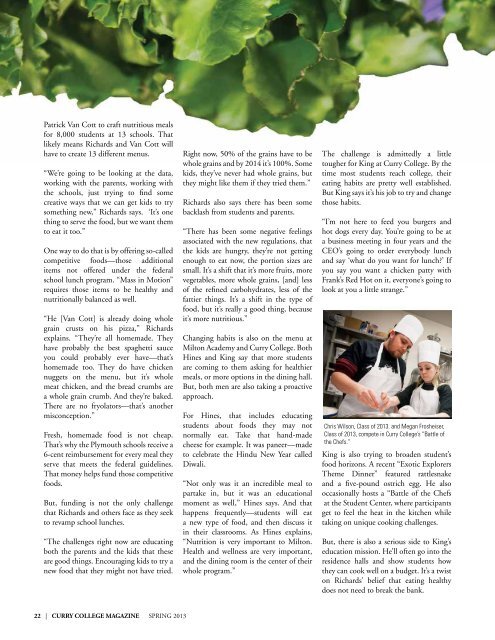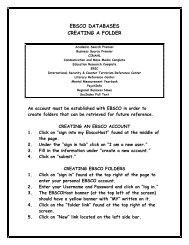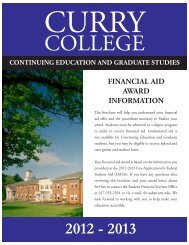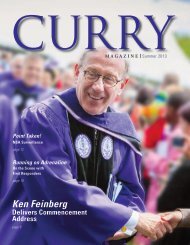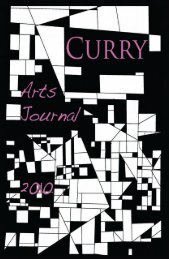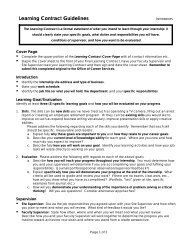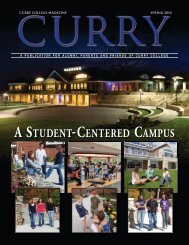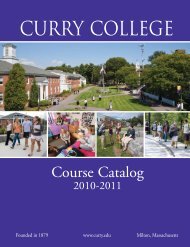Supplement Safety Changing the Face of School ... - Curry College
Supplement Safety Changing the Face of School ... - Curry College
Supplement Safety Changing the Face of School ... - Curry College
You also want an ePaper? Increase the reach of your titles
YUMPU automatically turns print PDFs into web optimized ePapers that Google loves.
Patrick Van Cott to craft nutritious mealsfor 8,000 students at 13 schools. Thatlikely means Richards and Van Cott willhave to create 13 different menus.“We’re going to be looking at <strong>the</strong> data,working with <strong>the</strong> parents, working with<strong>the</strong> schools, just trying to find somecreative ways that we can get kids to trysomething new,” Richards says. ‘It’s onething to serve <strong>the</strong> food, but we want <strong>the</strong>mto eat it too.”One way to do that is by <strong>of</strong>fering so-calledcompetitive foods—those additionalitems not <strong>of</strong>fered under <strong>the</strong> federalschool lunch program. “Mass in Motion”requires those items to be healthy andnutritionally balanced as well.“He [Van Cott] is already doing wholegrain crusts on his pizza,” Richardsexplains. “They’re all homemade. Theyhave probably <strong>the</strong> best spaghetti sauceyou could probably ever have—that’shomemade too. They do have chickennuggets on <strong>the</strong> menu, but it’s wholemeat chicken, and <strong>the</strong> bread crumbs area whole grain crumb. And <strong>the</strong>y’re baked.There are no fryolators—that’s ano<strong>the</strong>rmisconception.”Fresh, homemade food is not cheap.That’s why <strong>the</strong> Plymouth schools receive a6-cent reimbursement for every meal <strong>the</strong>yserve that meets <strong>the</strong> federal guidelines.That money helps fund those competitivefoods.But, funding is not <strong>the</strong> only challengethat Richards and o<strong>the</strong>rs face as <strong>the</strong>y seekto revamp school lunches.“The challenges right now are educatingboth <strong>the</strong> parents and <strong>the</strong> kids that <strong>the</strong>seare good things. Encouraging kids to try anew food that <strong>the</strong>y might not have tried.Right now, 50% <strong>of</strong> <strong>the</strong> grains have to bewhole grains and by 2014 it’s 100%. Somekids, <strong>the</strong>y’ve never had whole grains, but<strong>the</strong>y might like <strong>the</strong>m if <strong>the</strong>y tried <strong>the</strong>m.”Richards also says <strong>the</strong>re has been somebacklash from students and parents.“There has been some negative feelingsassociated with <strong>the</strong> new regulations, that<strong>the</strong> kids are hungry, <strong>the</strong>y’re not gettingenough to eat now, <strong>the</strong> portion sizes aresmall. It’s a shift that it’s more fruits, morevegetables, more whole grains, [and] less<strong>of</strong> <strong>the</strong> refined carbohydrates, less <strong>of</strong> <strong>the</strong>fattier things. It’s a shift in <strong>the</strong> type <strong>of</strong>food, but it’s really a good thing, becauseit’s more nutritious.”<strong>Changing</strong> habits is also on <strong>the</strong> menu atMilton Academy and <strong>Curry</strong> <strong>College</strong>. BothHines and King say that more studentsare coming to <strong>the</strong>m asking for healthiermeals, or more options in <strong>the</strong> dining hall.But, both men are also taking a proactiveapproach.For Hines, that includes educatingstudents about foods <strong>the</strong>y may notnormally eat. Take that hand-madecheese for example. It was paneer—madeto celebrate <strong>the</strong> Hindu New Year calledDiwali.“Not only was it an incredible meal topartake in, but it was an educationalmoment as well,” Hines says. And thathappens frequently—students will eata new type <strong>of</strong> food, and <strong>the</strong>n discuss itin <strong>the</strong>ir classrooms. As Hines explains,“Nutrition is very important to Milton.Health and wellness are very important,and <strong>the</strong> dining room is <strong>the</strong> center <strong>of</strong> <strong>the</strong>irwhole program.”The challenge is admittedly a littletougher for King at <strong>Curry</strong> <strong>College</strong>. By <strong>the</strong>time most students reach college, <strong>the</strong>ireating habits are pretty well established.But King says it’s his job to try and changethose habits.“I’m not here to feed you burgers andhot dogs every day. You’re going to be ata business meeting in four years and <strong>the</strong>CEO’s going to order everybody lunchand say ‘what do you want for lunch?’ Ifyou say you want a chicken patty withFrank’s Red Hot on it, everyone’s going tolook at you a little strange.”Chris Wilson, Class <strong>of</strong> 2013. and Megan Frosheiser,Class <strong>of</strong> 2013, compete in <strong>Curry</strong> <strong>College</strong>’s “Battle <strong>of</strong><strong>the</strong> Chefs.”King is also trying to broaden student’sfood horizons. A recent “Exotic ExplorersTheme Dinner” featured rattlesnakeand a five-pound ostrich egg. He alsooccasionally hosts a “Battle <strong>of</strong> <strong>the</strong> Chefsat <strong>the</strong> Student Center, where participantsget to feel <strong>the</strong> heat in <strong>the</strong> kitchen whiletaking on unique cooking challenges.But, <strong>the</strong>re is also a serious side to King’seducation mission. He’ll <strong>of</strong>ten go into <strong>the</strong>residence halls and show students how<strong>the</strong>y can cook well on a budget. It’s a twiston Richards’ belief that eating healthydoes not need to break <strong>the</strong> bank.22 | CURRY COLLEGE MAGAZINE SPRING 2013


